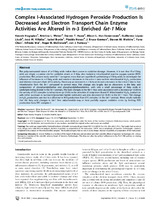Complex I-Associated Hydrogen Peroxide Production Is Decreased and Electron Transport Chain Enzyme Activities Are Altered in n-3 Enriched fat-1 Mice

Ver/
Autor
Hagopian, Kevork
Weber, Kristina L.
Hwee, Darren T.
Van Eenennaam, Alison L.
López-Lluch, Guillermo
Villalba, José Manuel
Burón, Isabel
Navas Lloret, Plácido
German, Bruce
Watkins, Steven
Chen, Yana
Wei, Alfreda
McDonald, Roger B.
Ramsey, Jon J.
Editor
Public Libray of Science (PLOS)Fecha
2010Materia
n-3 fatty acidsoxidative damage
METS:
Mostrar el registro METSPREMIS:
Mostrar el registro PREMISMetadatos
Mostrar el registro completo del ítemResumen
The polyunsaturated nature of n-3 fatty acids makes them prone to oxidative damage. However, it is not clear if n-3 fatty
acids are simply a passive site for oxidative attack or if they also modulate mitochondrial reactive oxygen species (ROS)
production. The present study used fat-1 transgenic mice, that are capable of synthesizing n-3 fatty acids, to investigate the
influence of increases in n-3 fatty acids and resultant decreases in the n-6:n-3 ratio on liver mitochondrial H2O2 production
and electron transport chain (ETC) activity. There was an increase in n-3 fatty acids and a decrease in the n-6:n-3 ratio in liver
mitochondria from the fat-1 compared to control mice. This change was largely due to alterations in the fatty acid
composition of phosphatidylcholine and phosphatidylethanolamine, with only a small percentage of fatty acids in
cardiolipin being altered in the fat-1 animals. The lipid changes in the fat-1 mice were associated with a decrease (p,0.05) in
the activity of ETC complex I and increases (p,0.05) in the activities of complexes III and IV. Mitochondrial H2O2 production
with either succinate or succinate/glutamate/malate substrates was also decreased (p,0.05) in the fat-1 mice. This change
in H2O2 production was due to a decrease in ROS production from ETC complex I in the fat-1 animals. These results indicate
that the fatty acid changes in fat-1 liver mitochondria may at least partially oppose oxidative stress by limiting ROS
production from ETC complex I.
